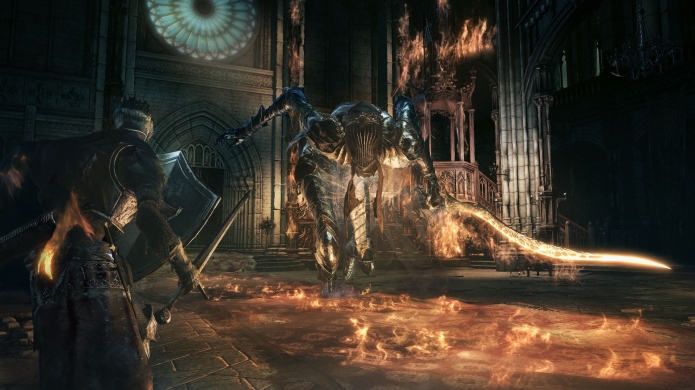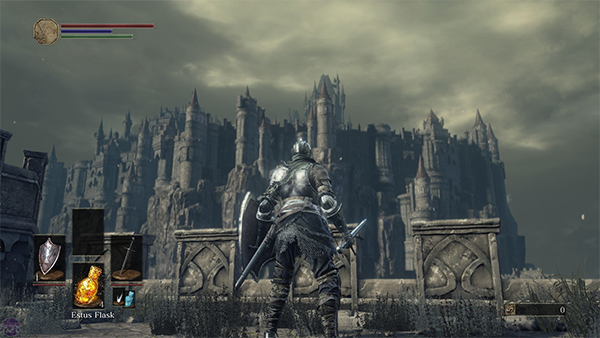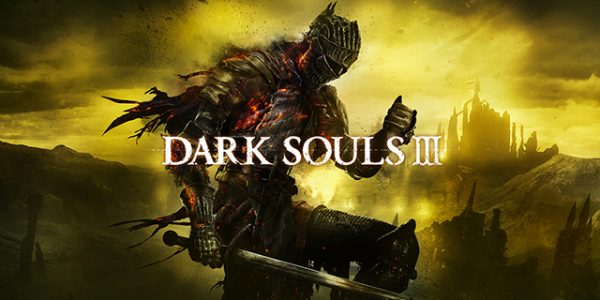 Just uttering the name can strike fear into the hearts of unhardened heroes. Only the fiercest, most grizzled, and perhaps most masochistic warriors possess the mettle to face the many challenges that lay ahead, be it across the land of Boletaria, Lordran, Drangleic, or the latest dark frontier of Lothric.
Just uttering the name can strike fear into the hearts of unhardened heroes. Only the fiercest, most grizzled, and perhaps most masochistic warriors possess the mettle to face the many challenges that lay ahead, be it across the land of Boletaria, Lordran, Drangleic, or the latest dark frontier of Lothric.
Dark Souls III continues the saga of courageous undead heroes fighting to rekindle the First Flame and prolong the Age of Fire, thereby saving the world for yet another cycle of relative peace from the horrors that arise as the flame dwindles and darkness encroaches.
For players, that means that FromSoftware and Hidetaka Miyazaki have built yet another massive world to explore, full of formidable foes, great and small. And while difficulty in the Souls-iverse has proven to be entirely subjective due to the wide range of character builds, combat strategies, and custom-forged weapons available, this may very well be the toughest journey to date.
Dark Souls III is once again helmed by the director of the first three Souls games, and after some negative response from the most entrenched of the Souls community to Dark Souls II (an excellent game that brought great improvements to the series, by the way), much of what’s found in this newest entry feels crafted to oppose elements of that game’s design and call back to Dark Souls and even the seminal Demon’s Souls. Dark Souls III therefore feels somewhat like an anthology of Souls history or an amalgamation of elements from its predecessors.

And the choices are mostly strong. Enemy design is creative and varied, giving players new and interesting foes to combat throughout the adventure. This is only amplified by the fact that enemy behavior and attack patterns follow suit and keep players guessing with each new onslaught. The game’s pace seems to have taken a cue from FromSoftware’s 2015 game, Bloodborne, making combat feel more active as a result.
For those who know and love the Souls franchise for its more measured, cautious exploration, however, this may strike a subtle chord and leave a particular itch unscratched, because for every step to “improve” combat in this way, some of the old atmosphere is lost.
Which brings me to perhaps the most unwelcome change in Dark Souls III: a notable homogeneity in its art direction. Level design—pathfinding and progression—has shifted in a way that will please some and disappoint others, but the aesthetic design of the environments in Dark Souls III has lost its diversity, and with it much of the sense of wonder that came with stepping into a new area for the first time in previous games. Here, most of the areas serving as backdrops to the famous Souls gameplay are stone castles or stone towns or stone catacombs or stone roadways. There’s still an impression of size and expanse—you can look back from a later area and see your journey’s distant starting point in miniature rising above the horizon—but these views no longer inspire awe quite the way they did in the past.

Exploration suffers on a visceral level due to this change of scenery, or lack thereof. And because the geography of Dark Souls III consists mostly of a string of discrete areas on a continuous path, the opportunity to direct one’s own adventure feels somewhat revoked in this game, as well. Previous Souls titles consistently put players in a position where they could choose their next move from a number of possible paths forward to who-knows-where. Dark Souls III presents an intricate and impressive web of pathways within each area, but the overall map features fewer branches, and therefore less mystery and trepidation to the adventure as a whole.
It’s in the mechanics that Dark Souls III‘s fire burns brightest. The aforementioned enemy AI works in synergy with a refined and improved combat system that includes new weapon-specific skills as well as a new system via which players divide their estus flask’s healing ability between health and focus points, the latter of which power both skills and spells. These elements, along with a general tightening of controls across the board, add layers of depth and complexity to what was already a brilliant design from a mechanical perspective.
For some, this will be enough. The tactile feedback of a world fighting as hard as ever back against you will be incredibly satisfying, and the difficulty upon which the legend of the Souls games has been built is at its peak in Dark Souls III. But for others, the essence of the Souls games lies in its world, oppressive and daunting not simply because of its inhabitants but by virtue of its mood; by the character of the place itself. While it was still great, Dark Souls III just couldn’t captivate me to the extreme degree that its predecessors—my favorite games—were able to do. For me, the fierce opposition in these games may be what fuels their challenge, but it’s the world that consumes my soul.


















